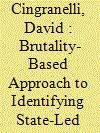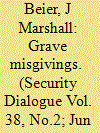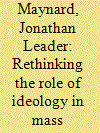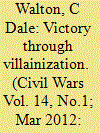|
|
|
Sort Order |
|
|
|
Items / Page
|
|
|
|
|
|
|
| Srl | Item |
| 1 |
ID:
187393


|
|
|
|
|
| Summary/Abstract |
The comparative study of atrocities and atrocity prevention faces several obstacles including a lack of consensus on the universe of cases and too few cases to statistically test alternative theories. The brutality-based (BB) conception is based on the idea that widespread, state-led violations of physical integrity rights constitute an assault on the personhood and human dignity of the members of society— a mass atrocity. Applying this idea to all countries annually systematically identifies a larger number of atrocities and facilitates categorization into three levels of intensity. The BB methodology for generating annual atrocity lists is replicable and transparent. The findings show that, between 1981 and 2019, the frequency of atrocities as defined and identified by other projects has been decreasing, but BB atrocities have been increasing. The sequence of different types of widespread physical integrity violations suggests new avenues for research on atrocity occurrence, escalation, de-escalation, and cessation.
|
|
|
|
|
|
|
|
|
|
|
|
|
|
|
|
| 2 |
ID:
077355


|
|
|
|
|
| Publication |
2007.
|
| Summary/Abstract |
Days after the December 1890 US Army massacre of Lakota refugees at Wounded Knee, South Dakota, commercial photographer George Trager photographed the Army burial detail as they cleared the site and committed the dead to a mass grave. Widely circulated as post-cards, Trager's photographs merged with a broader colonial narrative, allegorically and cathartically sketching a heroic account of a dire confrontation between `civilization' and `savagery'. Reconfirming dominant ideas about an inherently dangerous foe, the Wounded Knee photos worked through colonial imaginaries in ways that reinforced a Euro-American monopoly on legitimacy in war. More recently, widely circulated photos of abuse of prisoners by US soldiers at Baghdad's Abu Ghraib Prison have effected a disruption of the operant war narrative. Whereas Trager's photographs worked to sustain stable definitions of moral `civilization' and `savage' depravity, those from Abu Ghraib have undermined the legitimacy of US conduct in Iraq. In this article, I consider these differing effects with reference to photographic composition and the popular functions of allegory and catharsis
|
|
|
|
|
|
|
|
|
|
|
|
|
|
|
|
| 3 |
ID:
134992


|
|
|
|
|
| Summary/Abstract |
There is a widespread sense amongst theorists of genocide and other violent atrocities that ideology matters. But in spite of this agreement all is not well with actual efforts to theorise ideology's role. Theoretical and empirical coverage has been uneven, and there has been little if any effort to incorporate theories and research from the actual specialist field of contemporary ideology studies. As a result, overarching theoretical accounts of the role ideology plays in violent atrocities remain limited and problematic. This article aims to encourage theorists to think about ideology in a more systematic and productive fashion by analysing four questions: (a) what do we mean by ideology?; (b) who, in cases of atrocity, might be relevantly affected by ideology?; (c) how do these people come to be influenced by atrocity-justifying ideologies?; and (d) how might ideology encourage these people to commit, or permit, mass violence? In discussing these four questions, I aim to clear up a number of misconceptions or vagaries that frequent current analyses of ideology in works on atrocity and political violence. I ultimately offer a suggestive account of six recurring “justificatory mechanisms” which collectively describe some of the common features of ideology's role across cases of mass atrocity.
|
|
|
|
|
|
|
|
|
|
|
|
|
|
|
|
| 4 |
ID:
111224


|
|
|
|
|
| Publication |
2012.
|
| Summary/Abstract |
Although international war crimes law as such is a relatively recent development, claims that one's enemy has stepped outside the accepted boundaries of warfare have occurred throughout recorded history. In the last few decades, however, the globalization of media, the development of ever-cheaper digital recording devices, and other social and technological trends have allowed war crimes accusations to become an increasingly potent tool which insurgents can use to delegitimize the state which they are fighting. Indeed, insurgents have become so effective at using such techniques that many internationally prominent state leaders fiercely demand that states observe the laws of war but do not make similarly rigorous demands of insurgents. This article discusses how various insurgents, particularly those in conflict with US military forces, have guided global perceptions and used the aforementioned broader social and economic trends so as to create this advantageous outcome.
|
|
|
|
|
|
|
|
|
|
|
|
|
|
|
|
|
|
|
|
|